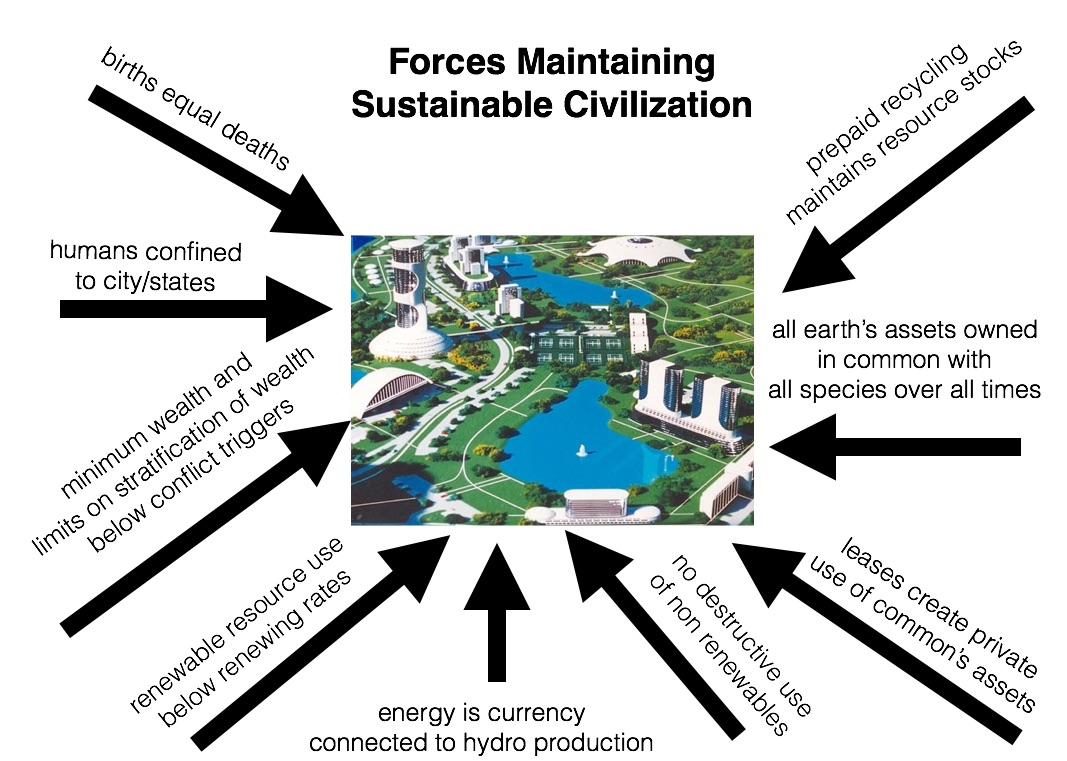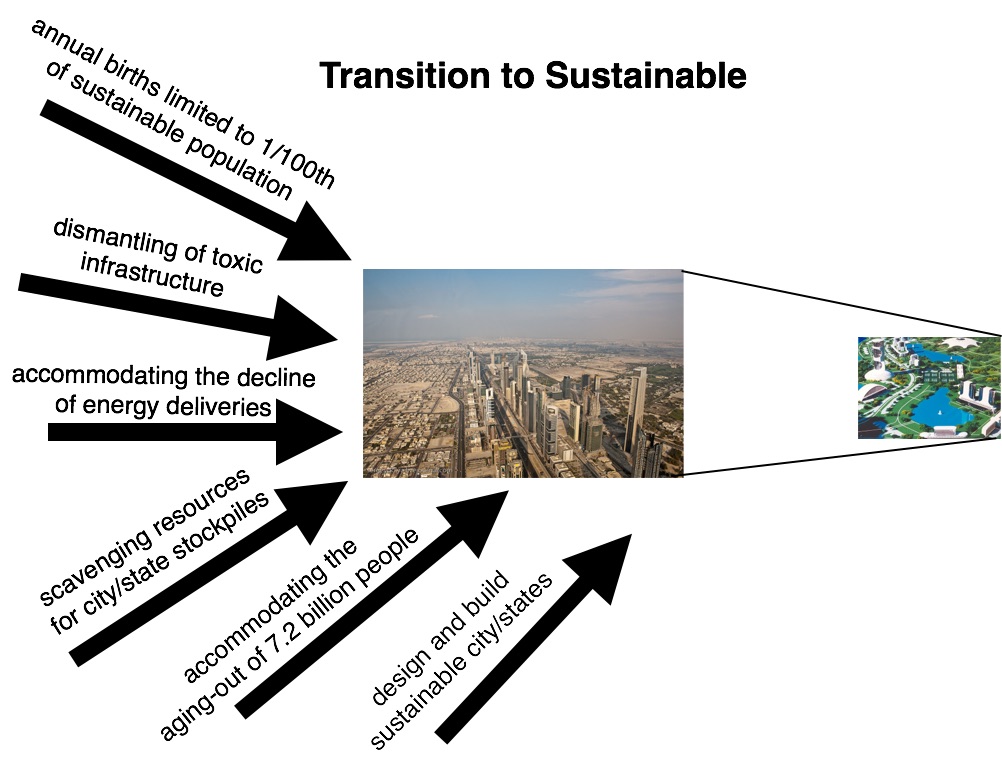There are many forces that shape a civilization. I describe these forces in two overlapping groups. In the first group are forces that would maintain a sustainable non-injury producing civilization (e.g. SKIL Note 100) that would provide a constant or improving level of goods and services to each member of the population and leave 98% of the world's environment natural for the years 2100 to 2400.
The second group of forces, somewhat overlapping the first, are the forces that would help our present civilization (the one that is or will be more than 100 times too big to be supported by the energy deliveries of 2100) transition to the new sustainable design in 84 years.
Group 1 -- Maintenance Forces

The first group of forces are similar to the forces created by the operational rules of the international space station; the forces that maintain its tranquility, and sustainability, with some additions to reflect the physical differences between the space station and earth.
1) Maintaining constant Population
maximum -- controlled by a birth permit lottery
minimum -- controlled by publicly created incentives
most women get to have the number of children they want 0-8
2) Directing production of food, goods, services, arts, and technology
supply side
labor
intellectual contributions
discretionary energy allocations
not leased
existing infrastructure
stockpiled resources
space
environmental services
demand side
consumer preferences
common good electives
creation and maintenance of the shared infrastructure
buildings
paths and parks
transportation
healthcare
education
public services (waste, fire protection, local law enforcement, etc.
3) Maintaining access to supporting assets
make all physical assets part of the commons
"lease only access" to commons' assets for private use
fixed terms
market value for lease
"Prepaid recycling" facilitates materials return to stockpiles
(each movement of material in manufacture,
may increase or decrease in the recycling escrow)
4) Maintaining environmental quality
limits on total leased services
renewing natural resources limited lease below renewing rates
material leases capped by fixed stockpiles (no additional mining)
human activity exclusion zones maintain the natural environment
5) Preventing the use of resources in social conflict
a) limiting absolute scarcity-
guaranteed high level services and discretionary income to each individual (96,000 kwh)
b) limiting the stratification of wellbeing
maximum salaries are limited to some multiple of 96,000 kwh baseline
the only individuals who live above that multiple receive profit from leasing/managing
production facilities
production streams (manufacturing, food, services)
royalty streams
investors (co lessors of production facility or royalty stream
(who also share
lease obligations
recycling escrow maintenance)
concentration of wealth is controlled by dilution.
inheritors of tokens, or token flows from production,
limited to some multiple of baseline.
(gifts summed from many sources cannot exceed the multiple of baseline)
owners of a production system can bequeath unlimited token flow
to a mutual benefit organizations MBO
MBOs have 50 million equal share holders.
MBO staff salaries are limited to multiple of 96,000 KWh
transfer of a material good to another person also means
transfer of lease responsibility for materials
possible increase in recycling escrow payments
Failure to pay lease requires further transfer to a third person, or
execution of the prepaid recycling option.
c) allowing opportunities to achieve elevated token flow above basis level
(wealth determined by production flows)
6) Maintaining clear lines of responsibility for leases
all leases held by individuals
(No corporate entities - no limited liability entities)
investors are proportional owners of leases (and lease liabilities)
when owners/investors die, or fail to transfer lease to new payee
mandatory execution of recycling using prepaid escrow.
Individuals or Mutual Benefit Organizations (MBO) receive benefits of production and
must pay prorated leases and accept prorated liability for recycling.
Group 2 -- Transition forces

Changing from a large, complex, out of balance, unsustainable, and decaying system, into a stable sustainable one requires additional forces to those needed to maintain sustainability once transition is achieved.
The most critical aspect of the transition can be visualized by thinking of earth as space station with 7.5 billion people living on it. The fuel to create and run this large infrastructure came from storage tanks that took millions of years of to fill by collecting and concentration dilute light energy from the sun.
During the last two centuries we have used this stored energy (coal oil and gas) millions of times faster than it is being created and we will soon run out. We will also run out of the fissile material uranium. Actually we will not be able to empty the tanks completely, we will get to a condition where it will take so much energy to extract the remaining energy resource from earth's crust, we will not get any energy to run civilization.
Our earth will have to run on the much smaller energy deliveries that can be collected and condensed from daily sunlight, for example solar thermal, solar photo voltaic, and it derivatives wind and hydro power.
Today these energy sources require the building of machines and supporting infrastructure to produce energy similar to that which we have been receiving from coal oil and gas.
Today these machines require so much surrounding infrastructure and labor, the entire energy delivery system, over periods of centuries, centuries that will not have coal oil and gas, to maintain this infrastructure, and feed and educate and entertain the labor that built and maintain them, may not produce any net energy. Some renewable energy systems in the long run may not run our present large civilization.
All may not be gloom and doom for humankind. The hydro electric production system, without the energy expenditures used to make the dams, might continue to produce net energy for 400 years. And this net energy might be able to support a small population (50 million) at high enough technology to find another viable energy source after the existing hydro system fails.
The resulting reduction in energy delivery this century means that because each food calorie is created with the use 9 fossil fuel calories (in plowing, planting, weeding, fertilizing, watering, harvesting, processing, and preparing) that a much smaller food supply will be produced.
If we expect a 50% reduction of energy delivery by 2050 and a more than 90% reduction by 2100 then we can feed less than 10% of the today's population. If we don't create this smaller population with a very small number of annual births replacing a normal number of natural deaths, we will starve to death the difference. And since people will fight to eat a conflict will consume food, infrastructure, and energy -- collapsing civilization.
It gets worse, this chaotic downsizing process will use up the remaining recoverable coal, oil and gas in the the earth's crust, and ruins the existing infrastructure, making it impossible to make the transition to my imagined high tech sustainable civilization that can develop a new energy source.
So finding the forces that make the transition, from our present civilization to one that is sustainable, go smoothly is a worthwhile goal. To design these forces we will start with some assumptions.
1) No new dense energy source will be brought on line in the next 85 years.
No cheap easy to build fusion reactors, liquid salt reactors, or access to dark energy.
2) Solar photo voltaic, solar thermal, geo thermal, wave, tidal, and wind, will improve their
efficiency but not enough to create enough net energy to support both the infrastructure
and human labor required to collect, concentrate, store, and distribute, the energy
for the envisioned 3 centuries of high tech society needed to
slip through Catton's bottleneck.
3) While the transition will require the available net energy that can be extracted from the
in ground fossil and uranium energy -- after 2100 they won't be viable energy sources.
4) As damaged as the environment might be in 2100 there will be habitable space for 50 million
people living European life styles in 3 city/states.
5) Each city/state is supported by
stockpiled resources scavenged from the previous civilization and
hydro electric power created by dams from the previous civilization
the dams will produce enough energy to
maintain the dams for the period 2100 to 2400 (but not build new dams) and
provide all of the new design's energy needs.
The most important force in this transition will be the one that produces rapid decline in population. The force limits the number of annual births. The decline results from the number of annual deaths far exceeding the number of births. For example (500,000) annual births and 80-100 million annual deaths.
Population decreases by ~90 million per year. Assuming the average age at death of 80 this means most of the existing 7.5 billion people will die of old age by 2100. The replacement community will total the total number of births - nominally 50 million in 100 years.
While this decline in people will not initially decrease total consumption, (most consumption not consumed by the exiting 90 million will be consumed by those still alive.
What will decrease total consumption will be the decrease in total supplied energy. One would hope that the population would decrease faster than decreases in energy, but most projections see energy delivery falling faster. The projected injuries might be attenuated by a change in consumptive habits of the remaining population, but it is far more probable that starvation and conflict will determine who gets injured and when.
Using these remarks as a starting point for identifying the forces to help plan a transition, let me offer some objectives for the forces.
Remember, we are doing this exercise as a means of writing a social contract that creates these forces. So we have to define the forces carefully enough to craft a written contract containing rules of behavior, that can be chosen as the path forward over all alternative paths.
The forces have to:
maintain vital services required to support the whole human community
during the transition
eliminate most activities that are not essential to the transition process
(e.g. all forms of conflict)
sequentially abandon unneeded parts of the existing civilization
buildings, roads, bridges, power plants, rails,
transmission lines, ports, manufacturing facilities, trucks, cars, planes
schools one grade every year
successively reconsolidate world populations into selected transition cities.
decommission toxic hazards still embedded in the infrastructure
harvest/scavenge vital parts of the old civilization
material resources
knowledge
art9
technology
build out infrastructure for 3 city/states
living,
manufacturing/recycling
education
research and development
entertainment
food production
stock piles
energy production and delivery systems
health care
transport (without cars or air planes)
Staff the new cities with operations people
move the new lottery winners and their child into the new cities yearly
(eventually displacing staff jobs with people that won lottery tickets or
the children-that resulted from lottery tickets.)
